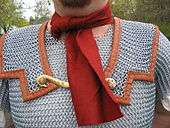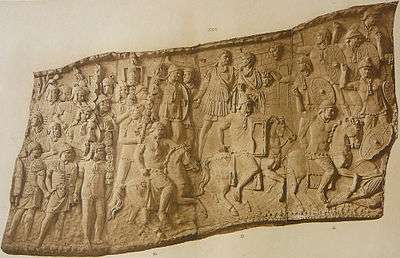Focale

The focale (plural focalia), also known as a sudarium ("sweat cloth"),[1] was a woolen or linen scarf worn by ancient Roman military personnel. It protected the neck from chafing by the armor.[2] The focale is depicted widely in military scenes from Roman art, such as the relief sculpture on the Arch of Septimius Severus in the Roman Forum[3] and Trajan's Column.[4] It is shown loosely knotted in the front, but is sometimes visible with the ends tucked inside the cuirass,[5]
In Latin literature, focale is a general word for a scarf or wrapping for the throat.[6] A focale was one of the gifts that might be given for the December festival of Saturnalia, according to Martial.[7] In one of his satires, Horace lists focalia among the "badges of illness" (insignia morbi).[8] In describing the correct attire for public speaking, Quintilian advises against wearing a focale, unless required by poor health.[9]

Although a sudarium often is used as a handkerchief, it can be worn like the focale as a neckerchief.[10] When Suetonius describes the overly casual attire of Nero, the emperor is barefoot, unbelted, and dressed in evening wear (synthesis), with a sudarium around his neck.[11] In late antiquity, orarium (Greek orarion) might be synonymous with focale, as in the description of military attire in the Vision of Dorotheus, and in a papyrus (dated 350–450 AD) listing military clothes.[12]
The focale is sometimes seen as one of the precursors of the necktie.[13] Cesare Vecellio (1530–1606) mentions the focale, calling it a cravata (cravat), as worn by Roman soldiers in his book on the history of fashion.[14] It has been compared to the amice (amictus) worn by Roman Catholic priests, which is depicted from the 6th century onward, as in the Ravenna mosaics.[15]
References
- ↑ Jason R. Abdal, Four Days in September: The Battle of Teutoburg (Trafford, 2013), p. 167.
- ↑ Nic Fields, The Roman Army of the Principate 27 BC-AD 117 (Osprey, 2009), p. 25.
- ↑ Richard Brilliant, "The Arch of Septimius Severus in the Roman Forum," Memoirs of the American Academy 29 (1967), pp. 139, 142, 155, 156, 158, 184, 186, 190, 197, 203, 210.
- ↑ John Hungerford Pollen, A Description of the Trajan Column (London, 1874), p. 111.
- ↑ Abdal, Four Days in September, p. 167; Liza Cleland, Glenys Davies, and Lloyd Llewellyn-Jones, entry on "scarf," Greek and Roman Dress from A to Z (Routledge, 2007), p. 166.
- ↑ Antoine Mongez, "Recherches sur les habillemens des anciens," Histoire et mémoires de l'Institute Royal de France 4 (1818), pp. 295–295.
- ↑ Martial 14.137 (142).
- ↑ Horace, Satires 2.8.255; article on "Dress," A Concise Dictionary of Greek and Roman Antiquities, edited by F. Warre Cornish (London, 1898), p. 259.
- ↑ Quintilian 11.3.144. Legwarmers (fascias quibus crura vestiuntur) and earmuffs (aurium ligamenta) are likewise to be avoided.
- ↑ Mongez, "Recherches sur les habillemens des anciens," p. 295.
- ↑ Suetonius, Nero 51; Mongez, "Recherches sur les habillemens des anciens," p. 295.
- ↑ SB VI.9570.5; Jan Bremmer, "An Imperial Palace Guard in Heaven: The Date of the Vision of Dorotheus," Zeitschrift für Papyrologie und Epigraphik 75 (1988), p. 86.
- ↑ Daniel K. Hall, How to Tie a Tie: Choosing, Coordinating, and Knotting Your Neckwear (Sterling, 2008), p. 8.
- ↑ Oscar Lenius, The Well-Dressed Gentleman (LIT Verlag Münster, 2010), p. 93.
- ↑ Charles Panati, Sacred Origins of Profound Things (Arkana, 1996), n.p.; Mongez, "Recherches sur les habillemens des anciens," p. 296.